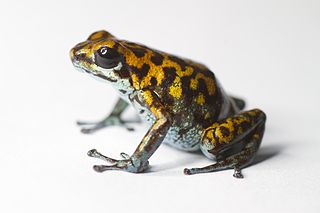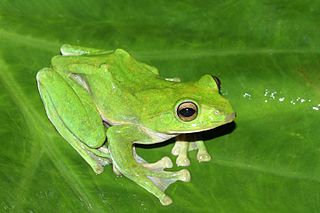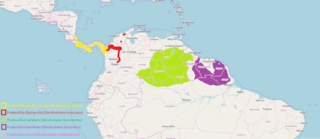The sky-blue poison frog is a species of poison dart frog. It is endemic to Peru and known from the lower eastern versant of the Andes in the upper Amazon basin of the San Martín Region.

Andinobates altobueyensis is a species of frog in the family Dendrobatidae. It is endemic to Alto del Buey mountain in the Serranía del Baudó range, in the Chocó Department of western Colombia. Its common names include Alto de Buey poison frog, golden poison-arrow frog, and golden poison frog.

The Cauca poison frog is a species of frog in the family Dendrobatidae. It is endemic to Colombia.
The yellow-bellied poison frog, yellow-bellied poison-arrow frog, or yellowbelly poison frog is a species of frog in the family Dendrobatidae. It is found in northwestern Colombia and east-central Panama.

The blue-bellied poison frog or bluebelly poison frog is a species of frog in the family Dendrobatidae.

The Andean poison frog is a species of frog in the family Dendrobatidae. It is endemic to Colombia.

Ranitomeya vanzolinii, also known as the Brazilian poison frog or spotted poison frog, is a species of frog in the Ranitomeya genus, from the poison dart frog family, Dendrobatidae. It is found in the Amazonian rainforests of Brazil and Perú, and possibly Bolivia.

Vicente's poison frog is a species of frog in the family Dendrobatidae that is endemic to the Veraguas and Coclé Provinces of central Panama.
The green poison frog is a species of frog in the family Dendrobatidae. They are a small green colored frog, approximately 14-16 millimeters in size. Their color is a uniform green with brighter green back and legs, while the ventral side of the frog is metallic. It is endemic to the western slope of the Cordillera Occidental, Colombia.

Andinobates virolinensis is a species of frog in the family Dendrobatidae. It is endemic to Colombia where it is confined to the Santander and Cundinamarca departments on the Cordillera Oriental.
Osteocephalus deridens is a species of frog in the family Hylidae. It is found in the Napo and Pastaza River drainages in eastern Ecuador and in the Loreto Region, northern Peru. The specific name deridens is derived from Latin deridere, meaning "make fun of someone". This alludes to the males calling from the treetops that sound "as if they are laughing at the collectors' vain attempts to reach them". Common name funny slender-legged treefrog has been coined for this species.
Osteocephalus fuscifacies is a species of frog in the family Hylidae endemic to Ecuador. It is known from the Napo River drainage at intermediate elevations. The specific name fuscifacies is derived from Latin fuscus (=tan) and facies (=face), in reference to the uniform tan-colored loreal region and the lack of a light subocular spot. Common name Napo slender-legged treefrog has been coined for this species.

The Andean marsupial tree frog, also known as the Riobamba marsupial frog or Riobamba pouched frog, is a species of frog in the family Hemiphractidae. It is endemic to Ecuador. The species is confined to the Andes and the inter-Andean valleys, from Imbabura south to Chimborazo. They live in an altitude of 2,200-3,500 meters above sea-level. The Andean marsupial tree frog's habitat varies from the montane forests to the dry rocky hillsides, and from the agave plants to the corn fields. Once a common species, it is threatened by severe habitat loss.

Chirixalus doriae, commonly known as Doria's Asian treefrog, Doria's bush frog, and Doria's tree frog, is a species of frog in the family Rhacophoridae. It is found in southeastern Asia, from extreme northeastern India and adjacent Bangladesh to Myanmar, Thailand, Cambodia, Laos, Vietnam, and southern China.

Zhangixalus smaragdinus is a species of frog in the family Rhacophoridae found in southwestern China, north-eastern India, Nepal, western Thailand, and northern Vietnam, and possibly in Bangladesh.

Dendrobatinae is the main subfamily of frogs in the family Dendrobatidae, the poison dart frogs of Central and South America, found from Nicaragua to the Amazon basin in Brazil.
Andinobates abditus is a species of poison dart frog, sometimes known as the Collins' poison frog. It is endemic to Ecuador where it is only known from its type locality, at the eastern base of the Reventador volcano, in the Napo Province.

The Rockstone poison dart frog is a poorly known species of dendrobatid frogs endemic to Guyana. As it is known from only one specimen, very little information is currently available on D. nubeculosus. It has been suggested to be one of the most poorly known species in the world.

Andinobates is a genus of poison dart frogs from Ecuador, Colombia and Panama. It contains species formerly classified in the genus Dendrobates and in 2006 transferred to the genus Ranitomeya. In 2011 Twomey, Brown, and their colleagues erected the genus Andinobates for a group of 12 species of Ranitomeya. Andinobates frogs can be distinguished from their sister taxon Ranitomeya anatomically in that their 2nd and 3rd vertebrae are fused. They show no limb reticulation, which is present in most species of Ranitomeya.

The Geminis' dart frog is a species of poison-dart frog distinguished by its uniquely small size and memorable mating call.














